
by Ian Stone | Jul 25, 2025
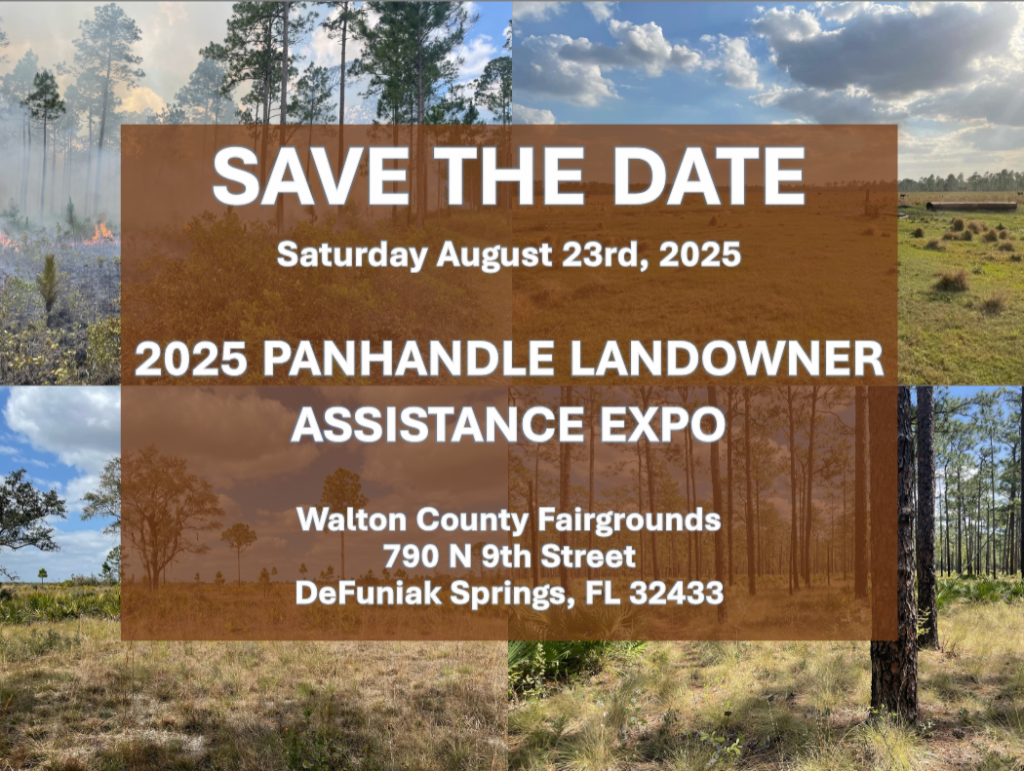
This August multiple partnering agencies, land management professionals, and landowners will come together for the first ever Panhandle Landowner Assistance Expo. This will be an all-day event at the Walton County Fairgrounds in Defuniak Springs, FL. The event itself will be 9 a.m. to 4 p.m. Saturday August 23rd. This will be the first of what all involved are very hopeful will be an annual event going forward. The goal is to build connections and provide information to help landowners meet their goals and build their land management network. The entire fairgrounds facility will feature a variety of informational and professional service provider booths, equipment show on the grounds, a series of presentations on land management topics, and presentations and tables on cost share programs from various agencies and non-profit organizations.
If you are a landowner or involved in land management and use in any way this event should be on your calendar and something to attend. Whether you own land for timber investment, agricultural or other rural use, homestead and lifestyle, or are involved in outdoor recreation through hunting clubs or similar activities; you will find great information and connections at the Expo! Currently the event team is conducting the panning and scheduling. Opportunities for sponsorships and other involvement exist beyond just attending. Through the generous involvement of the Walton County Fair Association and other organizations this event is being offered at no cost to attendees. Food Trucks will be on site as well to provide those attending with food and beverages as well (cost to attendees is based on vendor pricing).
The included Save the Date! Announcement and Event Flyer contain more details and the Eventbrite Registration. Registration is open and event capacity is limited so register early to ensure that you can attend. More details will be available as the presentation schedule and other details are available. If you are interested in being a sponsor or attending as a vendor please reach out to the event planners. The event chair is Ed O’Daniels, Private Lands Assistance Biologist with Florida Fish and Wildlife Commission, and he can be reached at Edward.ODaniels@MyFWC.com . Mark your calendars, you want won’t to miss this event!
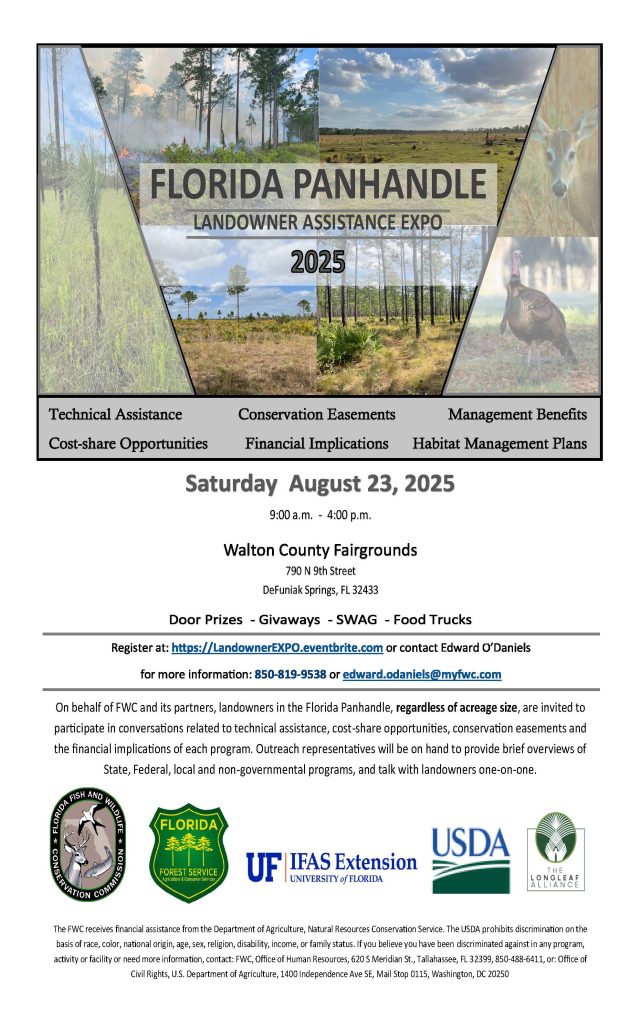 REGISTRATION
REGISTRATION
– Ian Stone, Panhandle Extension Forester

by Ian Stone | Nov 22, 2024
Each year in the fall you may notice tent-like webs in hardwood trees with dead or stripped foliage inside. These unsightly webs and foliage damage are caused by a common forest insect in our area, the fall web worm. These are the caterpillar phase of a native moth which tend to cause varying degrees of damage to tree foliage each year. Luckily, the caterpillars’ defoliation is usually late in summer to fall when the leaves are beginning to go dormant in hardwoods. Since the trees have stored most of the energy they need for the winter dormant period the defoliation fall web worms cause is usually not a problem especially on mature trees. Nonetheless the webs are often unsightly and in severe outbreak years they may completely defoliate some trees, particularly smaller and newly established trees. They can be controlled to some degree and luckily bad outbreaks are few and far between. Mostly fall web worms become a problem in home landscapes, orchards, and urban settings. In forests they tend not to cause significant damage but are noticeable due to the tentlike webs. In recent tree plantings for wildlife, they can be problematic by stripping the foliage on the trees.
Here in the Panhandle there can be several generation in a year, and as the growing season goes on the population grows. Earlier in the year the webs are smaller and the caterpillars feeding is less noticeable. By fall when the populations get large, the tentlike nests and stripped foliage is very noticeable. The caterpillars are gregarious and aggregate together close to where they hatch. The female moth lays eggs in the late spring in clutches on the underside of leaves. When the eggs hatch the caterpillars group together and start spinning webs out of silk as the young caterpillars skeletonize leaves. As they grow the web nest becomes larger and more foliage is consumed, forming the large unsightly tent nests we notice in the fall. They tend to form the web tent out toward branch tips and several colonies may form on a tree. The caterpillars only feed on foliage inside the web tent and expand they need more fresh foliage to feed on. The web is a natural defense against predators and by forming the tent nest they can feed in relative safety. As temperature cool and fall comes to a close the caterpillars leave the nest to pupate in leaf litter and bark crevices. They overwinter as pupa to become adult moths next spring. The wind and rain over winter usually removes the web nest and the tree puts on new growth next spring with no lasting damage.
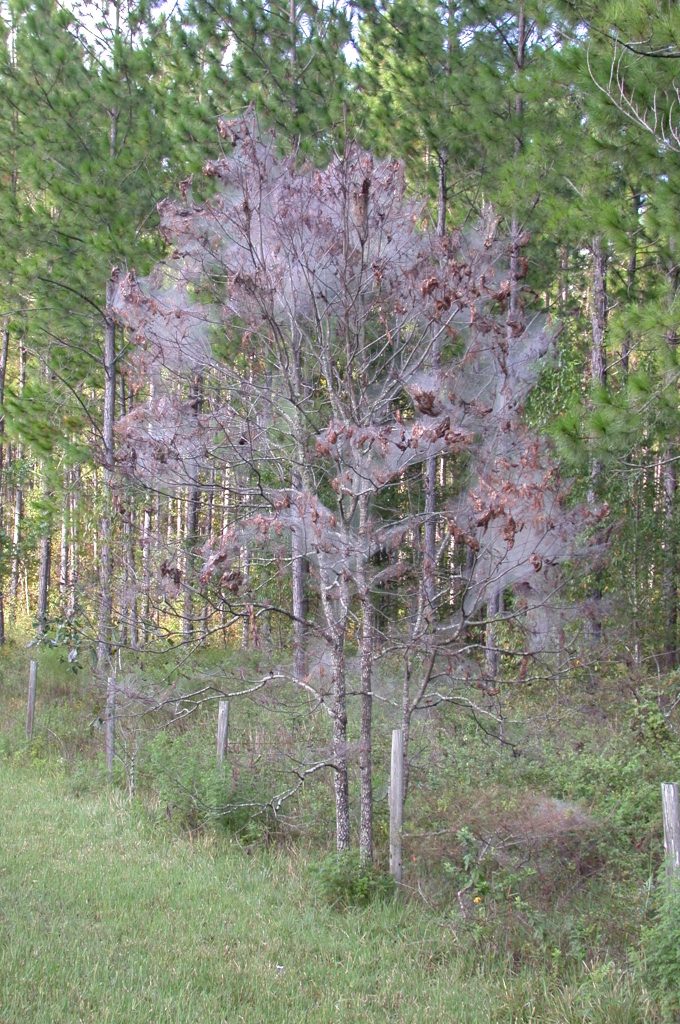
Fall Webworms defoliating a persimmon tree
Photo Credit: UF IFAS Entomology Department
Mostly webworms and their feeding activity are unsightly, especially in landscape settings. The main issue with fall web worm is when a large number of colonies form on a young tree, which can completely defoliate a tree. Orchards are another setting where large outbreaks of webworms can be an issue. When only a couple of web nests form on a tree control is usually not necessary except from an appearance and aesthetic point of view. Fall web worms have a broad range of host plants and will readily feed on a majority of deciduous hardwood trees and shrubs. They seem to favor pecans, hickories, walnut, and persimmon particularly along with sweetgum, yellow poplar, maples, and oaks to a lesser extent. Fall web worm is a particularly troublesome pest in pecan orchards and home landscape pecans. It is important to watch the extent of webworm infestation in these settings, particularly on younger trees. By the time late fall rolls around though removal of the webs and dead foliage may be helpful, but most trees have gone dormant for the year. On young trees that have had total defoliation this can weaken them during winter dormancy, so some TLC and extra attention in the spring are usually good follow ups.
Luckily since fall web worm is a native species there are plenty of predators, parasitoids, and disease that keep these pesky caterpillars in check. If you have a few fall web worm nests in your landscape there are some simple and effective control methods that can be used. One of the best is to simply destroy the web nests and expose the caterpillars to predators. The webs protect the caterpillars from birds and other predators and are their main defense. By simply taking a pole, tool handle, or other implement to reach the web you can simply tear it open and shake it, predators will help do the rest. Another option is to simply prune out the webbed branch, especially since they tend to be towards the tip. They can then be disposed of and the caterpillars along with them. Using sprays and pesticides are usually not extremely effective. Since the caterpillars are inside the dense web any spray usually cannot penetrate the protective web. Treatment of the foliage around the webs can be effective if applied earlier in the year since active feeding will ensure contact with control treatments. Several insecticidal soaps, horticultural oils, and effective insecticides are available and labeled for fall web worm control. This is only necessary in a severe outbreak and timing is everything. If you wait until mid to late fall most feeding activity has ceased and caterpillars will be beginning to pupate for winter, making pesticides ineffective.
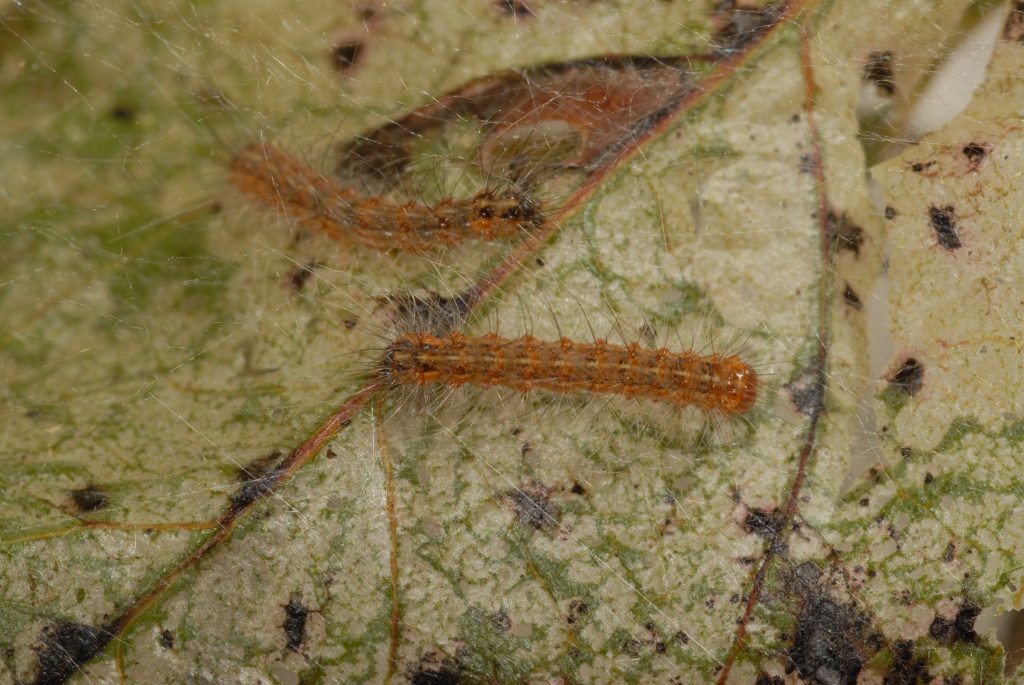
Fall web worm caterpillar in the early stages of development. Photo Credit: UF-IFAS Entomology Department
If you are seeing a bit of fall web worm in your area it likely catches your attention. If you have just a few branch tips affected the issue will likely go away on its own. Unless a tree is being almost completely defoliated this pest is more annoyance than anything, despite the unsightly and noticeable webs. If you are just now noticing an issue it is probably best to just wait and let the annual cycle play out. Fall webworm is an unsightly and annoying annual occurrence in trees but luckily it causes minimal damage and can be easily controlled. It is part of our natural landscapes and forests although it can be unsightly and concerning in years with significant outbreaks. For young or recently planted trees it only becomes an issue if complete defoliation occurs and usually the tree will shake this off and leaf out full next spring. Fall web worm can be noticeable and unsightly, but there is really no cause for concern in most cases. As with most things letting nature take its course and the annual cycle play out is usually the best option.

by Ian Stone | Aug 30, 2024
How are the live oak (Quercus virginiana) and the history of the United States Navy linked? That is a very interesting question that actually led to the first forest reservation and planting project in the United States. That reservation and history is still alive and well here in the Florida Panhandle, preserved still today as the Naval Live Oaks area of Gulf Islands National Seashore. In our modern times it may not register what forest and wood resources had to do with national defense but in the 1700’s and 1800’s it was key. In the times of wooden sailing ships having a Navy was key to being a Great Power. To have a powerful navy a nation had to have wood and shipbuilding resources, which meant access to forests. The abundant forest resources of North America were a driving force for colonization, especially for the British. Building the Royal Navy into the most powerful at the time required a huge amount of resources, which the American Colonies had in abundance. When our nation won its independence, it was similarly a major asset for the United States as the U.S. Navy was built. The U.S. government quickly recognized that these resource needed to be maintained and reserved, particularly the live oak which was a major wood resource with a limited supply. This led to the first forest conservation measure, which was the establishment of Naval Live Oak Reservations along the Gulf Coast in the early 1800’s.
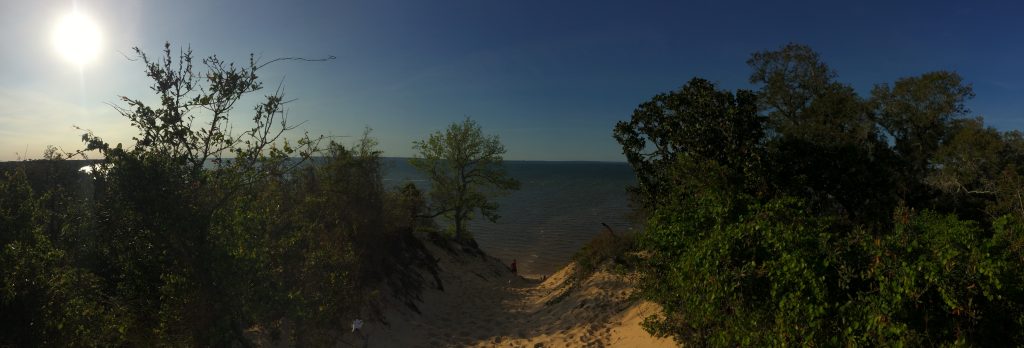
View from a high sand hill in Naval Live Oaks Gulf Breeze, FL Photo Credit: Ian Stone
Building sailing ships, required resources for the hull, masts, and waterproofing which all came from different trees and forest resources. Mast trees were in particularly high demand and usually were from particularly large and straight pines or spruce. This was a limited resource and the Eastern white pine (Pinus strobus) was a particularly good resource in North America. The southern pines were highly prized for production of naval stores which consisted of turpentine, tar, and rosin used for maintaining and waterproofing ships and their rigging. Oak was prized for hull construction, a live oak above the others. Live oak is exceeding strong and dense, one of the densest woods in North America. If you have ever experienced trying to split live oak for firewood you likely realize how hard it truly is. Axes and splitting wedges will bounce right off and barely crack a solid live oak log. It also grows in such a way that it was perfect for constructing the braces and complex hull components of ships. With these forest resources the United States had what it needed to begin building the United States Navy, a key component of national defense. In the War of 1812, the need for a strong Navy became readily apparent, and the U.S.S. Constitution would gain fame in its engagement with the Royal Navy on the open seas. U.S.S Constitution would get the nick name “Old Ironsides” from her strong live oak hull which appeared impervious to cannon shots during engagements. It is no wonder that the live oak resource was soon recognized as a critical need in expanding the Navy. President John Quincy Adams established the Naval Live Oak Reservation Program and in 1828 the Naval Live Oak Reservation was established in what is today Gulf Breeze, FL. Under the Department of the Navy a tree planting effort establishing young live oaks by planting acorns was established in the reserve. This made the Naval Live Oaks Reservation the first forestry preserve and one of the first managed forests in the United States. As with so many things it was national defense and the armed forces need for resources that lead to this program and reservation.
As live oak is a strictly North American species by the 1830’s the United States had near total control over this valuable resource. To ensure the resource was properly managed and not exhausted the Naval Live Oak Reservation system remained in place for nearly a century, with other reservations established along key areas along the Gulf and Atlantic Coasts. During this period almost all of the most significant live oak groves and resource was under Federal control for use in the building of naval ships. During the period through the civil war and just beyond this remained a critical resource for maintain Naval Power. By the start of the 20th century though wooden sailing ships had given way to steel steamers, and the live oak resource was no longer critical. In the early 1900’s many of the Naval Live Oak Reservations were returned to local governments, but the Naval Live Oaks remained in federal control. When the Gulf Islands National Seashore was created in 1971 it became part of that park under the National Park Service.

View of the Shoreline along the Naval Live Oaks Photo Credit: Ian Stone
Today you can go visit the Naval Live Oaks and experience the rich history as well as the pine and live oak forests that are part of the site. Unless you have done some history research or read some of the informational displays at the reservation the name may have been a bit puzzling. Today the forest resources at the Naval Live Oaks Reservation are not essential to our national defense. Live oak is now seldom used in lumber or other wood product applications and is largely ignored as a timber species. Today we can cherish this forest reservation for its conservation resources and the forest it preserves in an area that is heavily developed. It is a beautiful place to visit and hike, with a wonderful trail network both along the sandy hills and shorelines. You will need to have a Gulf Islands National Seashore pass as it is a fee area. It is well worth a visit to enjoy a unique forest ecosystem, which is truly unique historically. The natural beauty and habitat that the preserve covers are all due to the live oaks’ unique use in ship building during the age of sail. The live oak is a cherished and iconic tree in our region for many reasons, but when you visit the Naval Live Oaks consider the role it played in the development of the mighty United States Navy and our nation’s sea power in the era of wooden ships. While the original reason for the Naval Live Oak Reservation has past it still stands as a testament to the importance of forest resources to our nation nearly 200 years after it was founded.
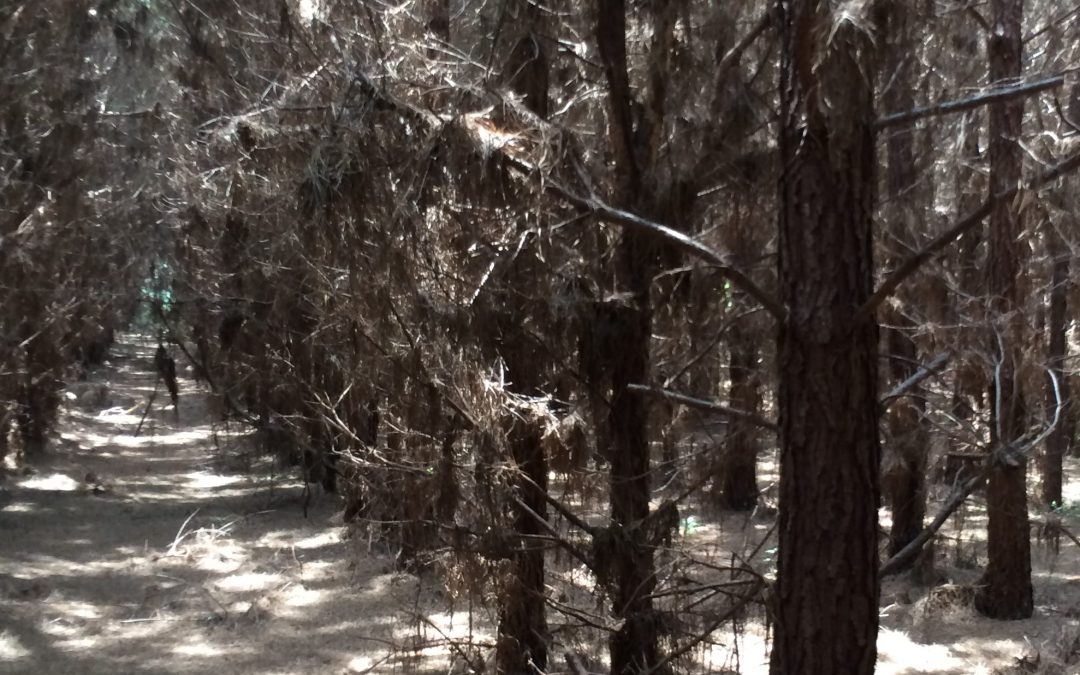
by Ian Stone | May 10, 2024
Thinning is an important part of any forest management plan and getting it right can be the difference between successful outcomes and persistent problems. Probably one of the most common questions foresters get is “Should I Thin My Trees?”. It is an important question to ask and definitely needs a forester’s input to get right. Thinning is part of managing the density of a forest stand and preventing issues with overstocking. If a stand is overstocked it causes multiple issues with the health and growth of a forest stand. Forest stands can even stunt when left in overstocked conditions and fail to produce the timber yield that would be expected. Not thinning at proper intervals when it is needed also results in lost growth even if the thinning is performed later. The key issue is competition and managing density prevents excessive competition among trees. To understand how thinning works you must understand some of how trees grow.
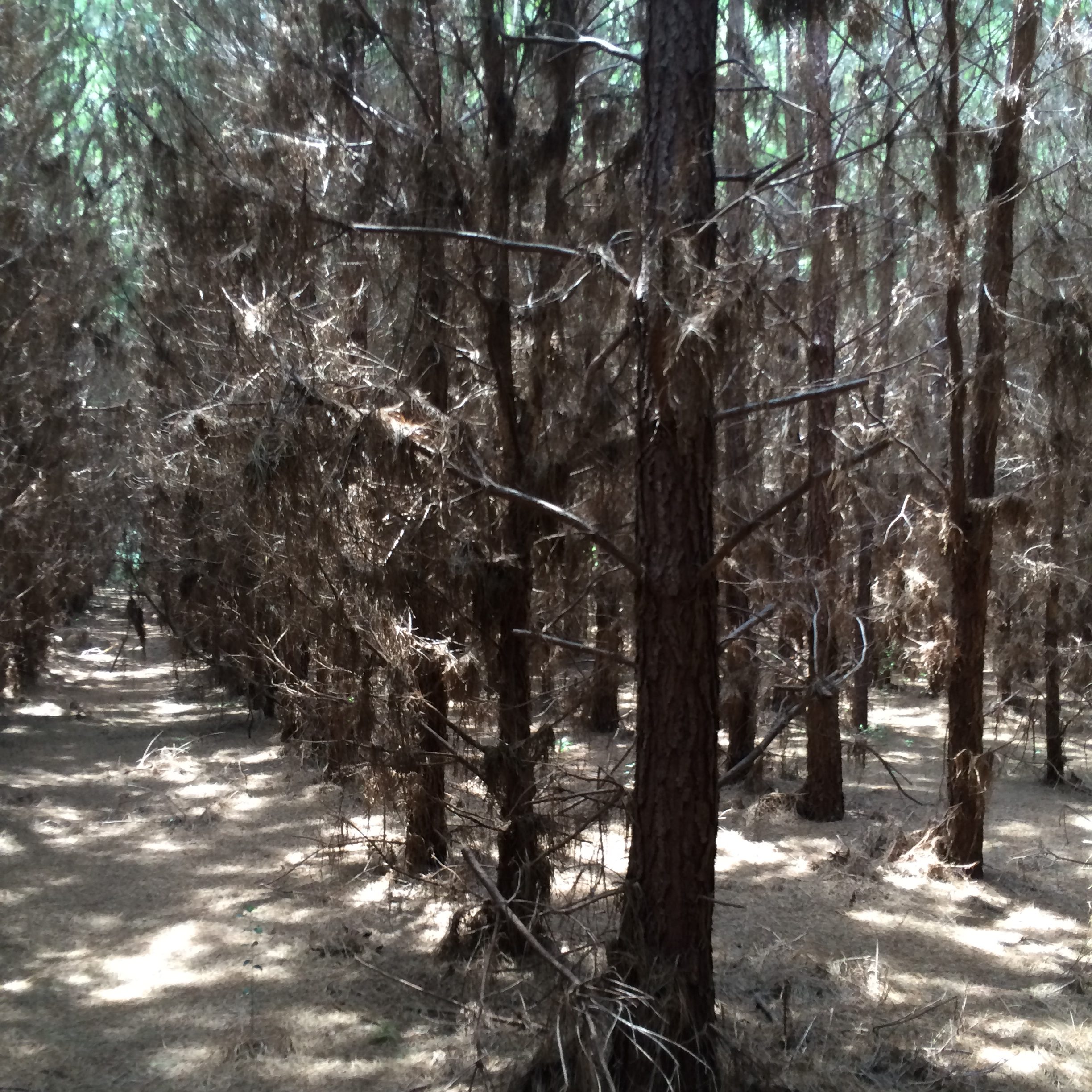
An overstocked pine stand in need of thinning Santa Rosa County, FL . Photo Credit: Ian Stone
Trees compete on a site for resources such as sunlight, water, and nutrients. As a young stand of timber develops the trees initially have plenty of resources while they are young and small, but they begin to compete when they grow older. Initially the competition can be a good thing encouraging taller and straighter growth habits and self-pruning of lower branches. As the stand develops though the competition becomes a negative factor when the trees begin to experience stress from lack of resources, primarily sunlight but also nutrients and water. At this point the stand is considered overstocked and thinning will improve the health and growth of the trees. Effectively thinning removes trees that are not needed and will eventually be out-competed and die. This allows a landowner to make some timber revenue while improving growth and health down the road. The trees that remain after thinning no longer are overstocked and competing and respond with improved growth and health. This important forest management technique is one of the primary management decisions in timberland ownership.
Overstocked stands create multiple issues that cause negative outcomes. One of the primary issues is that trees in overstocked conditions are weaker and more susceptible to insect and disease outbreaks. It is very common for bark beetle outbreaks and other issues to take hold in overstocked stands and produce considerable losses. Thinning is an effective measure at preventing this. Overstocked conditions result in poor growth and can lead to a situation where trees have a low portion of living foliage. Once this occurs a stand can become locked in a slow growing condition that can’t be reversed. This causes a loss of both volume and quality by reducing the development of high value saw-timber and poles. Overstocked and dense stands are also less desirable for wildlife and plant diversity. Thinning opens up the forest and allows more light and space which improves habitat and increases diversity on the forest floor and lower levels. All around thinning at the right time based on the forest conditions and stocking produces better outcomes. During thinning trees with form, disease, or other issues can be removed to improve the overall stand. Determining when and how to thin is a function of having a good forest inventory and monitoring tree size and stocking. There is usually a period of time that is referred to as a “thinning window” when the stand is beginning to become overstocked but will still produce a thinning response. This varies based on forest conditions and is more of a function of the size and density of the trees than an exact age or predetermined point in time. The best practice is to determine when a forest is entering the thinning window and take advantage of the thinning benefits. Delaying thinning will result in less optimal outcomes and results may be permanent. Similarly thinning too early or thinning incorrectly (too few or too many trees removed) can produce less desirable results. The key is to thin correctly and thin when forest conditions indicate it is needed.
Overall thinning is one of the best forest improvement practices available, and to get the most benefit it has to be done correctly. Far too often forest areas that need thinning are overlooked and go far too long without getting the thinning they need. You do not want to look into getting your timber thinned only to find out you should have done it 5-8 years ago or more. Worse still you develop a southern pine beetle out break and loose timber or start to have timber die from competition. The best way to make sure you stay informed on when and to what extent to thin is to have a forest management plan and update it regularly. Working with a consulting forester to inventory your timber stand and plan out forest management is one of the best things you can do. A good consultant forester can assist you in determining when and how to thin properly. They can also assist in marketing timber harvested in a thinning along with other services like timber marking. You can get assistance through the County Forester office with Florida Forest Service as well. You can work with the County Forester to enroll in the Forest Stewardship Program and get a management plan written at no cost to you. A forest management plan will cover thinning and other important practices to help you meet your goals. Determining when and how to thin is something that requires advice from a good professional forester. By working with a professional forester, you will avoid common pitfalls like making opportunistic thinning decisions, over-thinning, under thinning, leaving poor quality trees, and more. If you think your stand may need thinning contact the extension office, the county forester, or a professional forester of your choice. Making those contacts are a great first step in getting the most out of a good thinning.
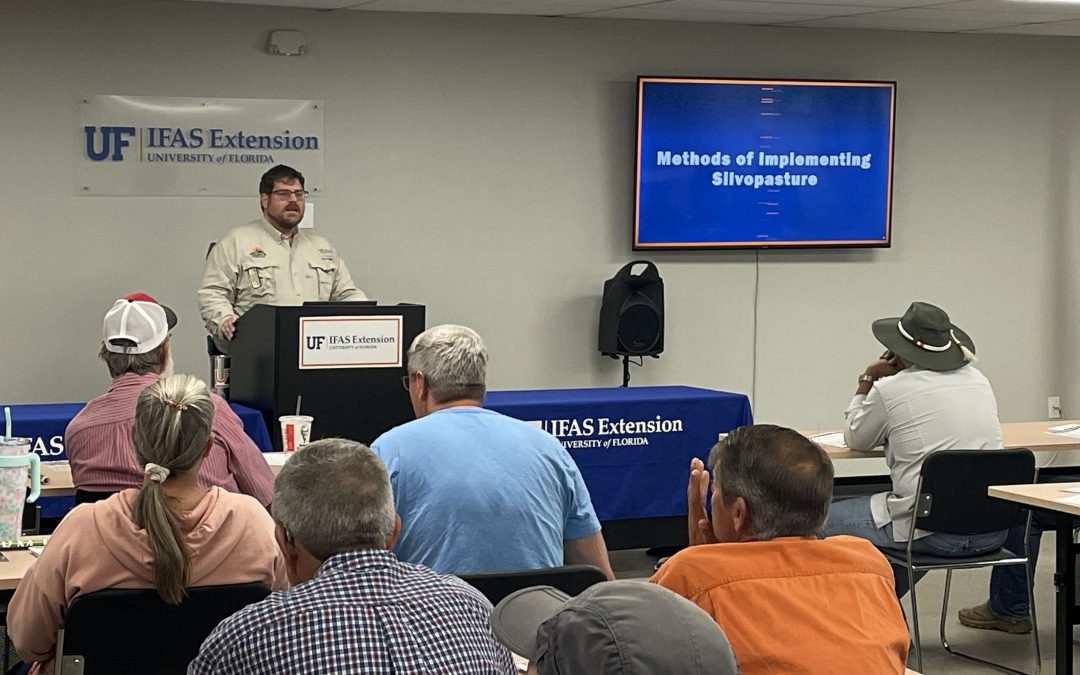
by Ian Stone | May 3, 2024
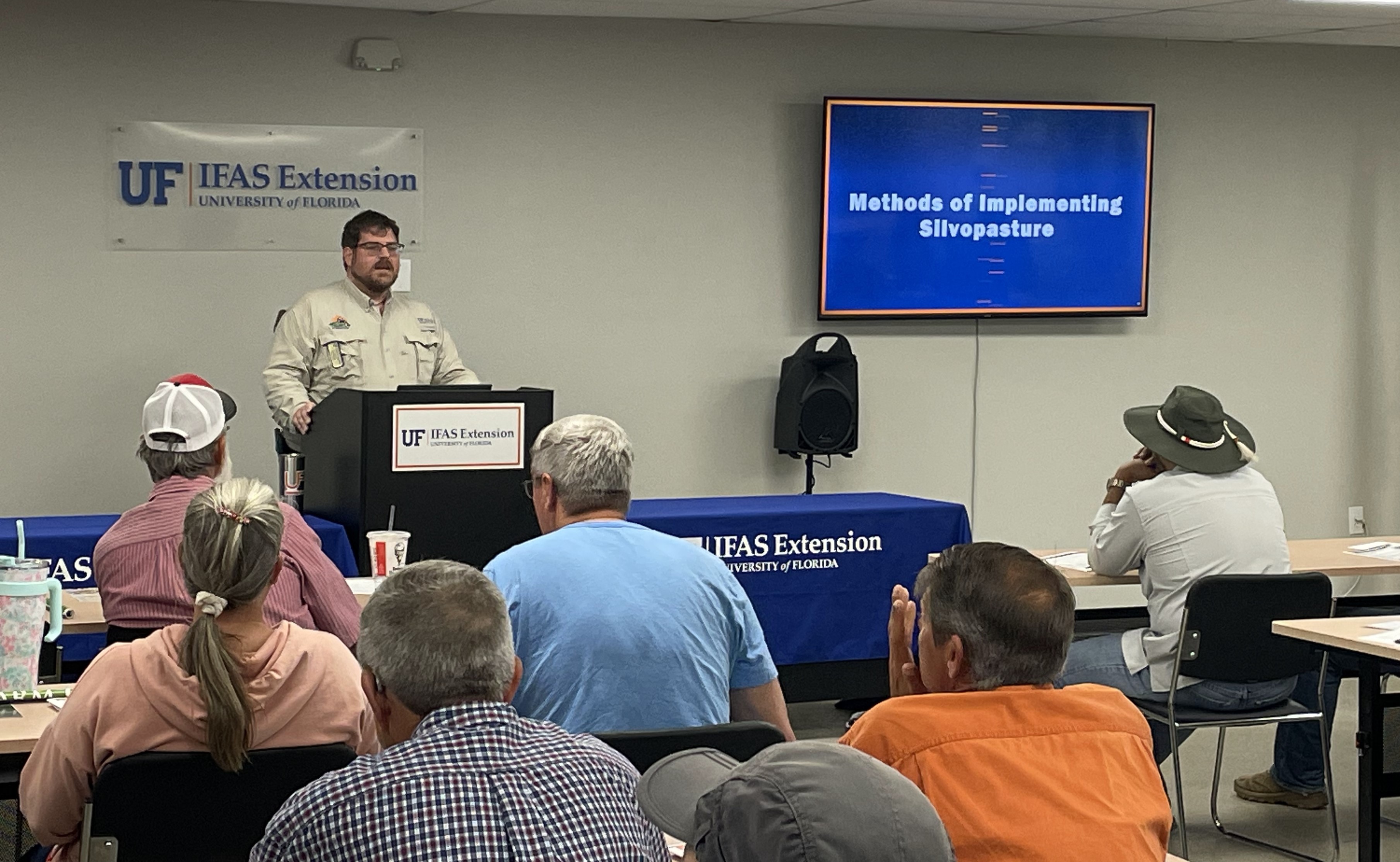
Forestry Agent Ian Stone Starts the Meeting and Teaches Participants about the Nuances of Timber Management in Silvopasture vs Traditional Timber Systems – Kacey Aukema
The UF/IFAS Extension Northwest District hosted a well-attended Silvopasture workshop and farm tour in Chipley on Friday April 26th. What exactly is silvopasture you may wonder? Ian Stone, the multi-county Forestry agent based in Walton County, did a great job in introducing the topic and overviewing how forestry management in silvopasture systems differ from more conventional timber systems in the first talk of the meeting. Silvopasture combines timber production and pasture production in the same area to allow for grazing animals to utilize the space in between tree and underneath tree rows for foraging. Silvopasture stands are much less dense than traditional stands of planted pines, to allow for adequate space for forage to grow and adequate sunlight to support forage growth. Implementing this kind of system can be achieved through thinning of an existing conventional timber stand “sIlvopasture by subtraction”, or intentionally planted in a density that would be conducive to forage production from the get-go. Ian’s presentation highlighted the attractive aspects of silvopasture production systems on how they facilitate multiple enterprises on one piece of property to diversify potential income streams, as well as the inherent constraints that these systems have when compared to timber or pasture/cattle production separately.
Okaloosa County Agriculture Agent Jennifer Bearden followed up Ian’s talk with a presentation on soils and soil management for silvopasture production. Depending on the tree species and forage species or variety optimal soil pH levels and fertilization needs may not line up perfectly for the grass vs. trees. Thus, proper soil testing to match the site with appropriate varieties and/or to guide how to amend the soil is important to balance the needs of the tree and forage crops being grown concurrently in these systems.
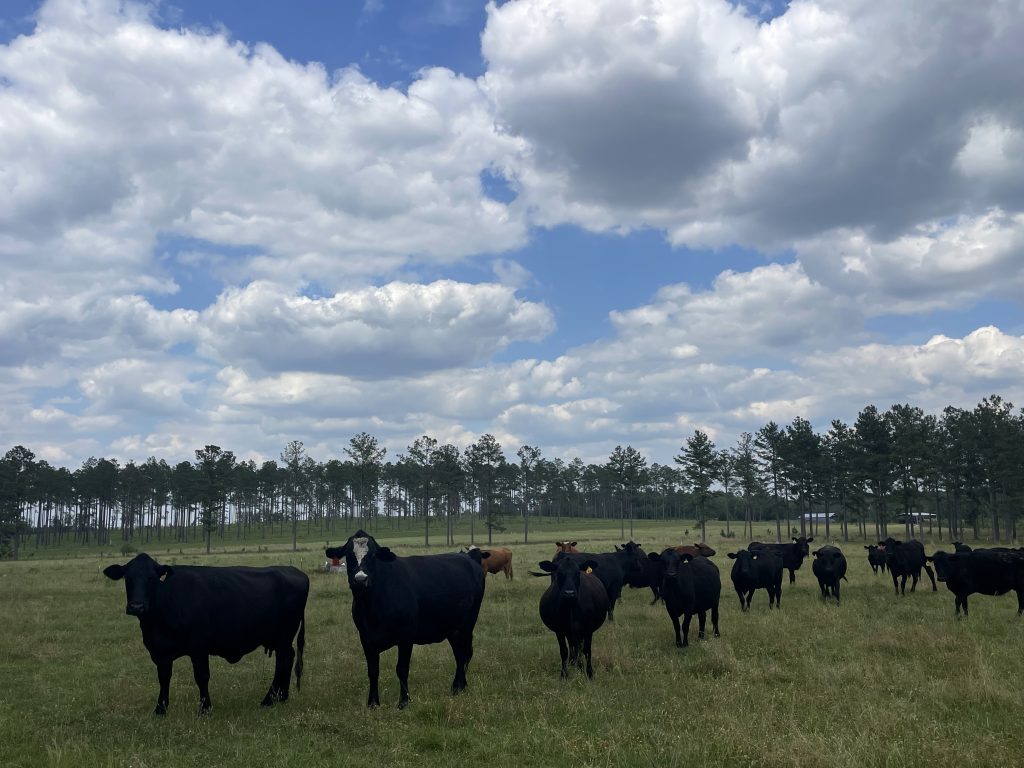
Cattle On The George And Pat Owens Property Are Rotated Between Conventional Pasture And Silvopasture Paddocks. – Kacey Aukema
Mark Mauldin, Washington County Interim Extension Director, and Nick Simmons Escambia County Extension Director also contributed with talks focusing on the interconnected topics of forage and livestock management in silovpasture systems. Not all forage varieties are well suited for the partial shaded environment and soil conditions that would be expected under silvopasture production. Therefore, picking the right species/variety for a particular site is important. Forage and livestock production in silvopasture systems often benefit from rotational grazing, therefore it is important to keep that in mind for pasture fencing and facilities planning to facilitate ease for rotating animals in and out of paddocks. One advantage of silvopasture systems for livestock and forages is from the partial shade provided by the trees. Shade reduces heat stress on the animals and can extend growth of some forages. For warm-season forages the partial cover provides a degree of frost protection, and for cool-season forages the shade provides cooler temps later into the spring.
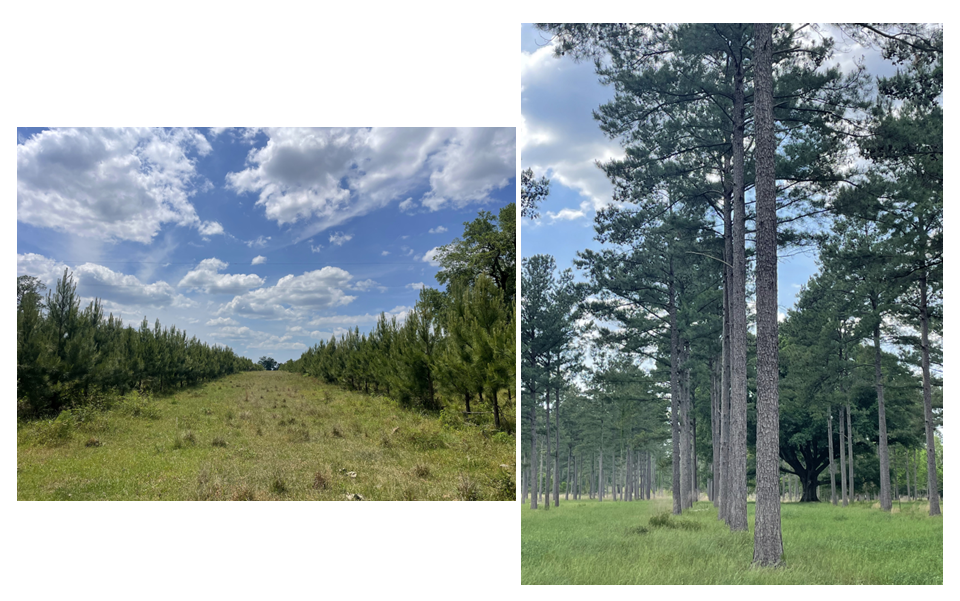
A ~5 Year-Old Stand Of Pines Planted For Silvopasture Following Damage From Hurricane Michael Currently Being Grazed (Left), And A 20+ Year Old Silvopasture Stand (Right) – Kacey Aukema.
Following the speaker program the attendees visited several different sites in silvopasture on the property of Geroge Owens–a local farmer and respected expert in silvopasture in the Southeast. Mr. and Mrs. Owens presented the site history at various stands of different ages of timber, and expounded on the strategies and experience they had gained over the years in managing the trees, pasture, and cattle on their operation. This included the impact of Hurricane Michael on their farm in 2018 and recovery since then. George and his wife Pat shared a wealth of experience during the tour and answered questions that attendees had about implementing these kinds of systems on their own properties.
We thank The Owens’ for hosting us on their property. Also we are grateful for The Florida Land Steward Program and Farm Credit of NW FL for sponsoring this event organized by Ian Stone, Mark Mauldin, and Chris Demers (Florida Land Steward Program Coordinator). We hope to continue to offer more educational programs related to silvopasture into the future.
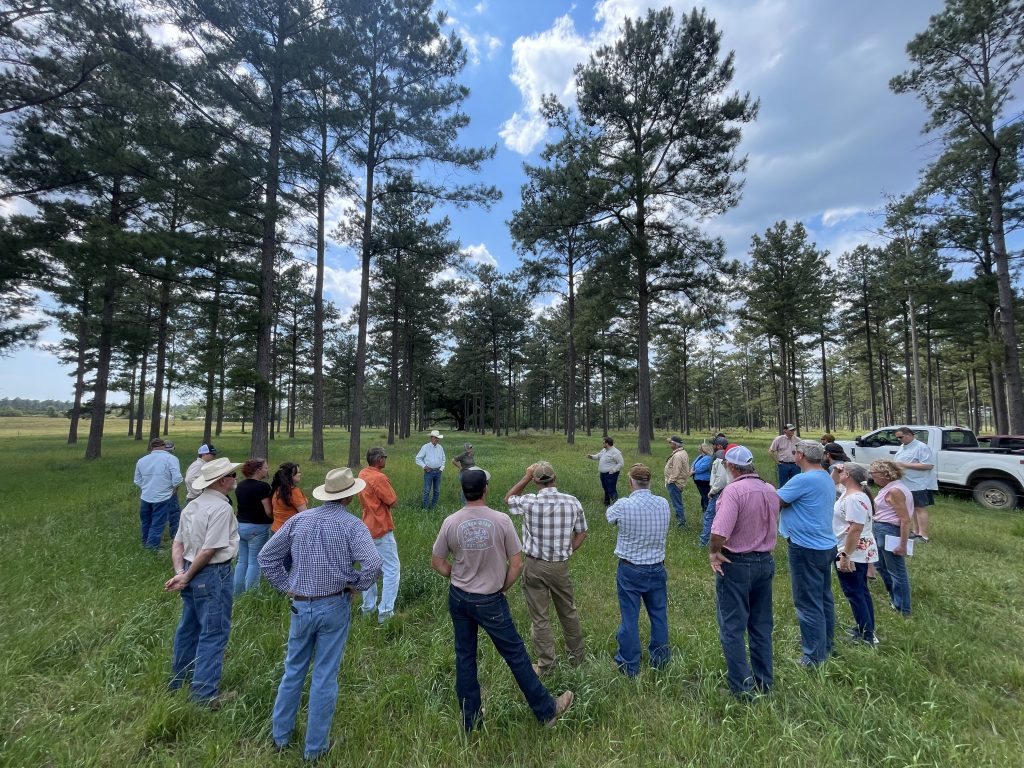
George and Pat Owens Share Their Wealth of Experience with a Group Touring Their Property – Kacey Aukema
To learn more about Silvopasture Systems for the Southeast see this great article from Mississippi State:
Silvopasture: Grazing Systems Can Add Value to Trees
Written By: Kacey Aukema, Agriculture Extension Agent in Walton County



 REGISTRATION
REGISTRATION











